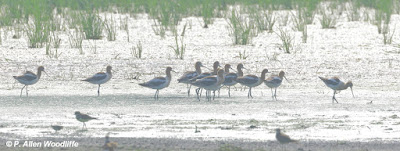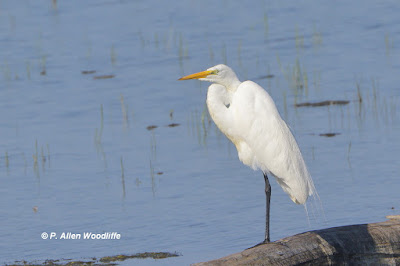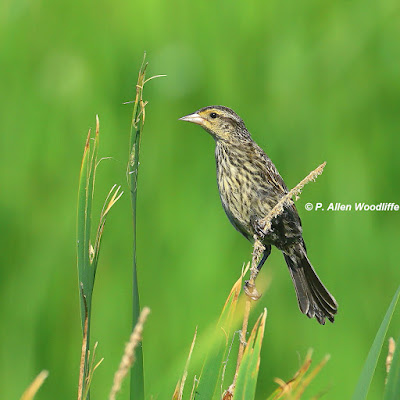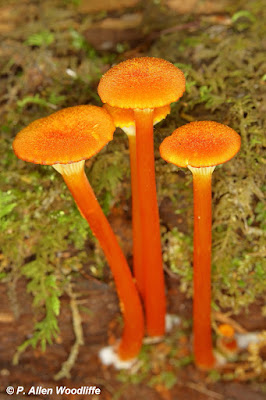A recent stop at the Blenheim sewage lagoons turned out to be quite worthwhile! I hadn't been there for a few days, as the ongoing heat and humidity encouraged me to stay close to home much of the time, but this day was different. Definitely a little cooler with a pleasant breeze. And something quite interesting had just blown in.
A flock of American Avocets was there, in the far southeast cell where there is a nice muddy flat and some shallow muddy water. As it was mid-morning, the light wasn't the best from the initial vantage point, and this is the best I could get, just in case they took off and I didn't have any other chances.
Walking cautiously on the dried mud, which was soft and full of cracks, I wandered more to the east to get a better angle of the light. It was still a little harsher than I liked, but through processing, was able to get some quite satisfactory photos.

At one point the entire flock of 12 got up and flew, appearing to go right out of sight, so we looked at the other shorebird diversity that was there. But in less than10 minutes, the Avocets returned. Not wanting to disturb them to flight mode again, we quietly backtracked and left them feeding.
Earlier I indicated that this flock had recently blown in. As it turns out, Blake had a flock of 12 flying in from Lake St. Clair, over the Mitchell's Bay area, about 3 hours earlier. It is quite likely that the ones he had seen, kept on flying until they found some wetland with shallow, muddy water, to their liking.
As is typical of sewage lagoons at this time of year, there are usually a few more things to take note of if there are some shallow, muddy edges. There were several Semipalmated Plovers, but I didn't get any photos of them. Lots of Killdeer, of course, and others of various types. At one point, under a bit breezy conditions, some swallows rested from their aerial flight on the gravel path.
 |
| Tree and Barn Swallows |
As I approached the sprinkler cells, two large corvids were up and about, giving a typical hoarse croak of Common Raven.
A few Least Sandpipers were scattered about.....
....as were a few Lesser Yellowlegs...
...and a couple of Pectoral Sandpipers.
It is always nice to see a few Short-billed Dowitchers.
This Tree Swallow was sitting on a sheltered perch, taking a rest from chasing insects that were probably taking shelter from the breezes themselves.
On another occasion, I went to the Mitchell's Bay North Shore Trail. With its openness it is always a good spot to go to keep away from mosquitoes and fewer deer flies, and with a few birds to note. This adult Bald Eagle was a long way off, keeping an eye on fishermen and whatever else that were out on the lake. I tried to get around the trail a little farther to get closer, but it would have none of that and took off.
Great Egrets are almost always around, and some even cooperated for some telephoto photos. I think there were at least 6 within view, although they moved around a bit.
A Common Gallinule was perched up in the Arrowhead and Pickerelweed squawking and complaining about something.
In the recently harvested wheat field, this pair of Sandhill Cranes was investigating some open area.
And this Song Sparrow was singing its heart out, so the nesting season, at least for it, is still under way.
Red-winged Blackbirds are almost always fairly abundant, and especially now when so many young have hatched. Many were out in the wheat field as well, likely looking for a bit of grain that hadn't been taken in.
And in other news....the Nessus Sphinx Moth that I photographed at home a few days ago, and is now my feature creature at the top, showed a slightly different look in one of the photos that I eventually got processed. This one shows a Great Golden Digger Wasp grasping on to the tail end of the moth! Not sure what its intent was, and it didn't last long, so perhaps the wasp figured it had tackled something too large for itself.
At Rondeau, I had noted a female Prothonotary Warbler taking nesting material to a natural cavity in one of the sloughs. I had hoped that it would make use of it, as there was a male nearby, and I prefer photographing this species at a natural cavity. But even after watching this spot periodically over the course of several weeks, it was apparent that nothing was happening here. Perhaps it found a better nesting cavity farther up or down the slough.
And this immature Red-tailed Hawk was being harassed by a small group of Red-winged Blackbirds. In this incident, it was the little guys that won the confrontation.
'Til next time....
If you would like to subscribe, or unsubscribe, to Nature Nuggets, send an email to: prairietramper@gmail.com









































































